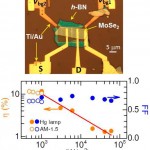Pronounced Photovoltaic Response from Multilayered Transition-Metal Dichalcogenides PN-Junctions
 Article: published in Nano Letters by Antonio I. Fernández-Domínguez, Francisco J. García-Vidal, Department of Theoretical Condensed Matter Physics and IFIMAC researchers.
Article: published in Nano Letters by Antonio I. Fernández-Domínguez, Francisco J. García-Vidal, Department of Theoretical Condensed Matter Physics and IFIMAC researchers.
Transition metal dichalcogenides (TMDs) are layered semiconductors with indirect band gaps comparable to Si. These compounds can be grown in large area, while their gap(s) can be tuned by changing their chemical composition or by applying a gate voltage. The experimental evidence collected so far points toward a strong interaction with light, which contrasts with the small photovoltaic efficiencies η ≤ 1% extracted from bulk crystals or exfoliated monolayers. Here, we evaluate the potential of these compounds by studying the photovoltaic response of electrostatically generated PN-junctions composed of approximately 10 atomic layers of MoSe2 stacked onto the dielectric h-BN. In addition to ideal diode-like response, we find that these junctions can yield, under AM-1.5 illumination, photovoltaic efficiencies η exceeding 14%, with fill factors of ∼70%. Given the available strategies for increasing η such as gap tuning, improving the quality of the electrical contacts, or the fabrication of tandem cells, our study suggests a remarkable potential for photovoltaic applications based on TMDs. [Full article]


















